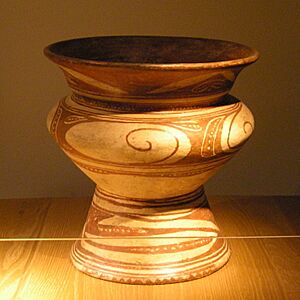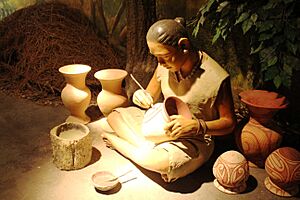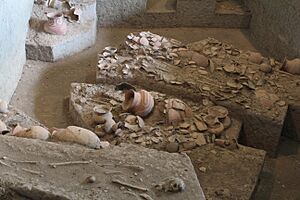Ban Chiang facts for kids
| UNESCO World Heritage Site | |
|---|---|
 |
|
| Location | Nong Han district, Udon Thani province, Thailand |
| Criteria | Cultural: iii |
| Inscription | 1992 (16th Session) |
| Area | 30 ha |
| Buffer zone | 760 ha |
Ban Chiang (Thai: บ้านเชียง) is an amazing ancient site in Nong Han district, Udon Thani province, Thailand. It's a special place where archaeologists find clues about people who lived long, long ago. Since 1992, it has been recognized as a UNESCO World Heritage Site. This means it's considered very important for everyone in the world to protect.
The site was first discovered in 1966. People became very interested because of the old, red-painted pottery found there. More recently, in 2008, Ban Chiang was in the news. Many ancient items from the site were found in museums far away. These items were later returned to Thailand, which was a big step in protecting history.
Contents
How Was Ban Chiang Discovered?
Local villagers had found some pottery before, but they didn't know how old or important it was. In 1966, a student named Steve Young was visiting the village. He was studying the Thai culture.
One day, Steve tripped over a tree root and fell. Right there, he saw the tops of old pottery jars sticking out of the ground! He realized these pots were very old and had unique designs. He showed them to experts, and soon, everyone knew Ban Chiang was a special place. Sadly, because the pots were so beautiful and old, some people started taking them from the site without permission.
What Did Archaeologists Find at Ban Chiang?
The Fine Arts Department of Thailand started digging carefully at Ban Chiang in the 1960s and 1970s. They found many interesting things. These included human skeletons, bronze tools, and lots of pottery. They even found tiny pieces of rice. This suggests that the people who lived here during the Bronze Age were likely farmers.
The oldest graves at the site don't have bronze items. This means they belong to an even older time, called the Neolithic period (New Stone Age). The most recent graves are from the Iron Age.
Digging Deeper in 1974-1975
A big excavation happened in 1974 and 1975. Experts from the University of Pennsylvania Museum worked with Thai archaeologists. Their goal was to learn more about the site and train new archaeologists.
They found two rich areas to dig. The famous red-on-buff pottery that first caught attention was actually from a later period (around 300 BCE to 200 CE). Beneath it, they found even older and equally interesting pottery.
Evidence of Metalworking
Even more exciting, the digs uncovered tools like crucibles. These are special pots used for melting metal. This showed that the people of Ban Chiang made their own metal items. They didn't just get them from other places. They created bronze bracelets, rings, spearheads, axes, and even small bells. After these digs, tons of artifacts were sent for study.
Archaeologists also learned that Ban Chiang was not just a burial ground. People were buried right next to or even under their homes. This practice is called residential burial.
How Did People Live at Ban Chiang?
Archaeologists found at least 142 burials during the 1974-1975 digs. Studying the human remains showed that these ancient people lived active lives. There was little sign of fighting or war. They got their food by farming, hunting, and gathering. They also knew how to work with metals. The fact that few metal weapons were found suggests that Ban Chiang was mostly a peaceful place for many centuries.
How Old Are the Ban Chiang Artifacts?
Figuring out the exact age of the Ban Chiang artifacts has been a bit tricky. Early tests suggested the site was very, very old, possibly the earliest Bronze Age culture in the world. This made people around the globe very excited!
However, later and more accurate tests using radiocarbon dating suggested different dates. It seems that metalworking at Ban Chiang began around 2000–1700 BCE. The oldest grave found, which had no metal, dates to about 2100 BCE. The newest graves are from around 200 CE. So, people lived at Ban Chiang for a very long time!
The Amazing Metallurgy of Ban Chiang
Ban Chiang and other nearby villages in northeast Thailand have many bronze artifacts. These show that people were skilled at metallurgy (working with metals) nearly four thousand years ago. This is special because ancient metalworking often happened in big cities or kingdoms. But in Southeast Asia, it happened in smaller villages like Ban Chiang.
Experts like Dr. Joyce White have studied these metals in great detail. They found that most copper and bronze items were made right in the local villages. They weren't made in big factories somewhere else. This tells us a lot about how these ancient communities worked and traded with each other.
Dr. White leads a project that has an online database. It shows all the metal items found at Ban Chiang and nearby sites. These items are sorted into groups like bangles, blades, bells, and tools. The database also shows when the items were made and what they are made of.
Ban Chiang: A UNESCO World Heritage Site
Ban Chiang became a UNESCO World Heritage Site in 1992. This means it's recognized as a place that tells a unique story about a culture that existed long ago.
The Ban Chiang National Museum
Today, many people visit Ban Chiang. The Ban Chiang National Museum helps visitors learn about the site. It shows how the site was discovered and what archaeologists have learned. The museum even has a special outdoor area that looks just like an actual excavation site. You can see how the ancient pottery and skeletons were found in the ground.
The museum also has a special exhibit called Ban Chiang, Discovery of a Lost Bronze Age. This exhibit has traveled around the world. It helps people understand the different time periods and cultures at Ban Chiang. There's even a virtual museum online where you can see some of the artifacts!
The museum and the site have become very popular. This has helped the local village, with new shops and restaurants opening for visitors.
Returning Ancient Treasures
In 2008, Ban Chiang was in the news because many ancient items from the site were found in museums in the United States. These items had been taken from Thailand without permission.
The US government started an investigation to find these items. They found thousands of artifacts from Ban Chiang and other sites in several museums. The goal was to make sure these important historical objects were returned to their rightful home.
Many museums that had these items agreed to return them to Thailand. For example, the Mingei International Museum returned 68 items, and the Bowers Museum returned 542 items. This was a big step in protecting cultural history. This case was important because it showed that museums and collectors have a responsibility to make sure the ancient items they have were obtained legally and ethically.
See also
- Ban Non Wat Archaeological Site
- Dong Son culture
Images for kids





